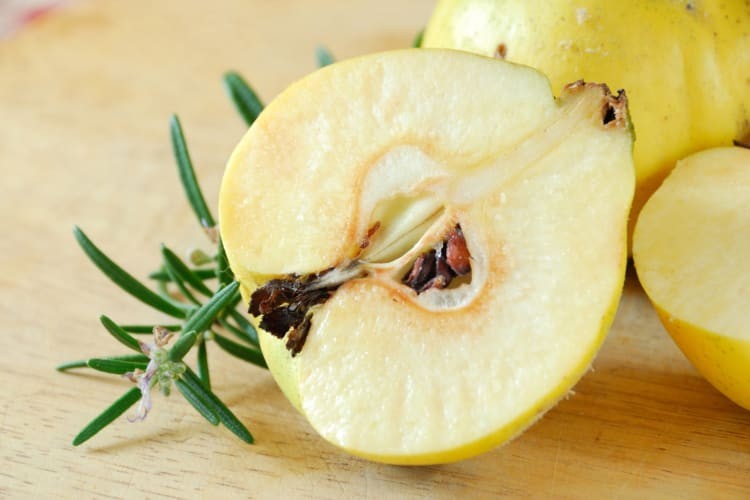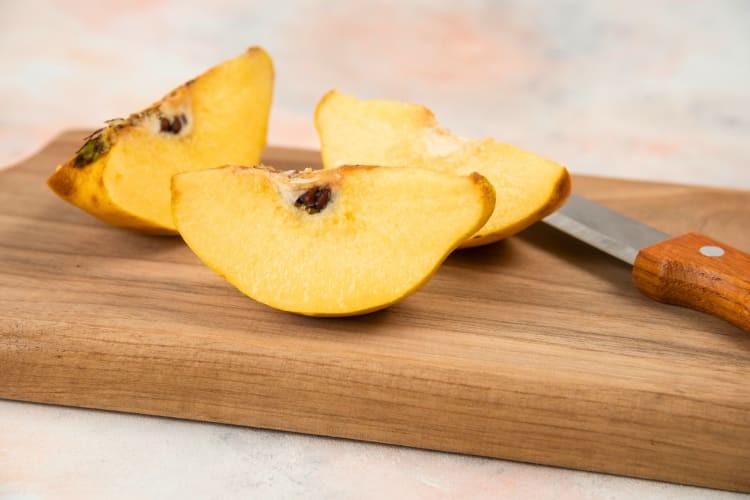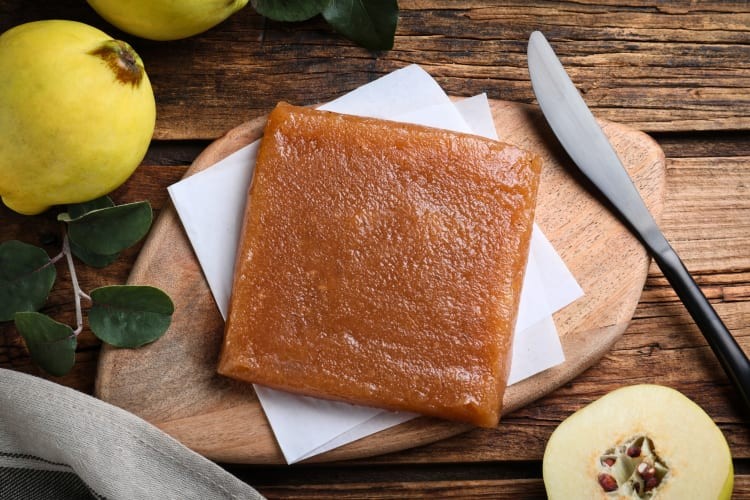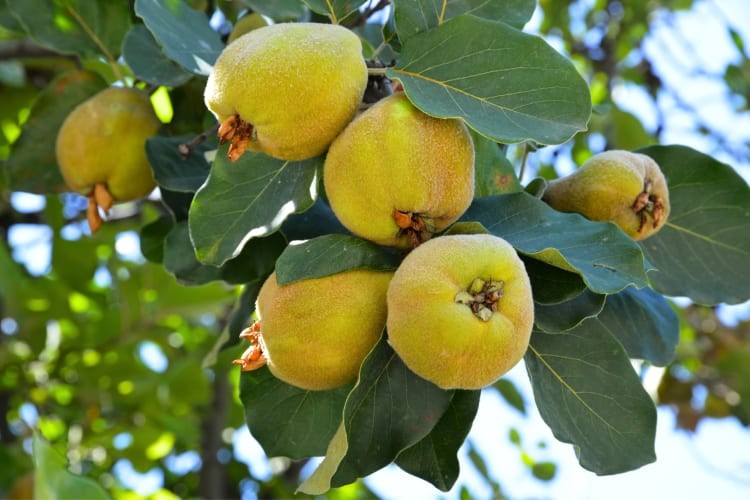Quince is a unique fruit, closely related to apples and pears, that offers a delightful twist to culinary creations when properly prepared. At WHAT.EDU.VN, we aim to provide you with quick and free answers to your questions, including everything you need to know about this intriguing fruit. Discover its characteristics, preparation methods, and health benefits, and unlock its potential in your kitchen. Explore interesting facts, culinary applications, and nutritional value to get a complete understanding of quince.
1. What Is Quince?
Quince is a fruit in the same family as apples and pears, known for its distinctive flavor and versatility in culinary applications. Native to the regions of Persia, this seasonal fall gem has been cherished for centuries.
When raw, quince is hard and astringent, but it transforms into a rosy-hued, soft delicacy when cooked. It is commonly used in jams, jellies, preserves, pies, and tarts, providing a unique flavor profile to these treats.
1.1. What Does Quince Taste Like?
The taste of raw quince is generally unappealing due to its hardness, graininess, and acidity, unlike milder fruits like pears. However, cooking transforms quince, giving it a pleasant, fruity, and sweet flavor with hints of vanilla.
Cooking softens the texture to a velvety consistency, contrasting with its initial firmness. Spices like cinnamon, cloves, or star anise can enhance the natural flavors during cooking.
1.2. What Does a Quince Look Like?
A quince fruit looks like a misshapen or bumpy yellow apple. It may appear greenish if picked before full ripeness, so look for golden-yellow fruits for the best flavor.
1.3. How Do You Pronounce Quince?
Quince is commonly pronounced as either “kwince” or “kince.” Both are acceptable, with most people accentuating the “qu” sound, pronouncing it as “kwins.”
1.4. What Is Quince Paste?
Quince paste, or membrillo, is the most readily edible form of quince, especially out of season. It is made by cooking quince fruit down to a jam-like consistency. Quince is high in pectin, which causes it to set into a firm paste when boiled in water.
Quince paste is versatile. It can be stirred into oatmeal or yogurt for a fruity flavor or used as a pastry filling. It’s also a perfect addition to a cheese board, pairing well with cheese due to its sweet-tart kick.
2. How To Eat Quince Fruit
Eating quince raw is not common because of its bitterness. It’s typically boiled before eating to soften its texture and mellow its bitterness, making it more palatable.
2.1. Can You Eat Quince Raw?
While you can eat quince raw, most people find it too hard and grainy. Chopping quince into small pieces and adding it to a salad can help you adapt to the raw taste. However, cooking is the optimal preparation method.
2.2. How To Prepare Quince for Eating
Preparing quince is simple but requires time. Start by removing the skin, cutting the fruit into quarters, and removing the seeds. Slice the quince into evenly sized pieces and boil in water for about 40 minutes.
As the quince cooks, it transforms from golden yellow to a pinkish hue, indicating readiness. This method unlocks the quince’s flavor, making it tender and delicious for culinary applications.
3. Is Quince Healthy?
Quince is a healthy fruit. Its grainy texture indicates high fiber content. It is also loaded with vitamin C and is low in calories, with about 57 calories in a 100g serving.
4. Where To Buy Quince Fruit
Quince is a seasonal fruit that can be hard to find. Farmers markets in apple and pear-growing regions are your best bet, as these orchards may have quince trees.
You can also find quince in the produce section of grocery stores during the fall. Look for golden yellow quince for the best flavor profile.
5. Unlocking the Culinary Potential of Quince: A Comprehensive Guide
Quince, often overlooked in the produce aisle, boasts a rich history and unique characteristics that make it a culinary gem. This section dives deep into various aspects of quince, offering insights into its origins, nutritional value, preparation methods, and diverse culinary applications. Whether you’re a seasoned chef or a curious home cook, understanding quince can open up a world of flavorful possibilities.
5.1. Historical Roots and Cultural Significance
Quince has been cultivated since ancient times, with evidence suggesting its presence in the Middle East and Mediterranean regions as early as 600 BC. The fruit held significant cultural value, symbolizing love, fertility, and happiness in ancient Greek and Roman traditions. It was often associated with weddings and celebrations. Over time, quince cultivation spread throughout Europe, where it became a popular ingredient in jams, jellies, and preserves.
5.2. Nutritional Profile and Health Benefits
Beyond its unique flavor, quince offers several nutritional benefits. According to a study published in the Journal of Food Science, quince is a good source of dietary fiber, vitamin C, and minerals like potassium and copper. Fiber aids digestion and promotes gut health, while vitamin C boosts the immune system and acts as an antioxidant. Potassium helps regulate blood pressure, and copper supports various enzymatic processes in the body. The study highlights that a 100-gram serving of quince contains approximately 57 calories, making it a low-calorie addition to a balanced diet.
5.3. Selecting and Storing Quince
Choosing the right quince is essential for optimal flavor and texture. Look for fruits that are firm, fragrant, and have a vibrant golden-yellow color. Avoid quinces with blemishes, soft spots, or a greenish hue, as these may be underripe. Quince can be stored at room temperature for a few days until it ripens, or in the refrigerator for up to two months. Wrap each quince individually in paper to prevent them from bruising.
5.4. Preparing Quince: A Step-by-Step Guide
Preparing quince involves a few essential steps to transform its tough, astringent raw form into a delectable ingredient.
Ingredients:
- Quince fruit
- Water
- Sugar (optional)
- Lemon juice (optional)
- Spices (optional)
Instructions:
- Wash: Rinse the quince under cool water to remove any dirt or debris.
- Peel: Use a vegetable peeler to remove the outer skin, which can be tough and bitter.
- Quarter: Cut the quince into quarters and remove the core, including the seeds.
- Slice: Slice the quince into evenly sized pieces for uniform cooking.
- Boil: Place the quince slices in a pot, cover with water, and add sugar, lemon juice, and spices as desired.
- Simmer: Bring the water to a boil, then reduce the heat and simmer for 40-60 minutes, or until the quince is tender and has turned a beautiful pink color.
- Drain: Drain the quince and use it in your desired recipe.
5.5. Versatile Culinary Applications
Quince can be used in various sweet and savory dishes, adding a unique flavor dimension to your culinary creations.
Sweet Applications:
- Jams and Jellies: Quince’s high pectin content makes it ideal for making jams and jellies. These preserves can be enjoyed on toast, scones, or as an accompaniment to cheese.
- Pastries: Quince can be used as a filling for pies, tarts, and cakes. Its sweet and slightly tart flavor pairs well with other fruits and spices.
- Compotes: Quince compote is a simple and delicious dessert that can be served warm or cold with yogurt, ice cream, or whipped cream.
- Quince Paste: Also known as membrillo, quince paste is a firm, sliceable preserve that is traditionally served with cheese.
Savory Applications:
- Meat Glazes: Quince can be used to make glazes for roasted meats such as pork, lamb, or duck. The sweet and tangy flavor of quince complements the richness of the meat.
- Sauces: Quince can be incorporated into sauces for poultry or game dishes. It adds a unique depth of flavor and helps to tenderize the meat.
- Stuffings: Quince can be added to stuffings for poultry or game birds, providing a sweet and savory element.
- Salads: Roasted or grilled quince can be added to salads for a burst of flavor and texture. It pairs well with greens, nuts, and cheese.
5.6. Quince in Global Cuisines
Quince has been incorporated into various cuisines around the world, each with its unique twist on this versatile fruit.
- Mediterranean Cuisine: In the Mediterranean, quince is often used in savory dishes, such as tagines and stews. It is also made into a traditional sweet called “dulce de membrillo” in Spain and Latin America.
- Middle Eastern Cuisine: In the Middle East, quince is used in meat dishes, such as lamb tagine with quince and apricots. It is also used to make jams and preserves.
- European Cuisine: In Europe, quince is commonly used in jams, jellies, and pastries. It is also used to make a traditional quince cheese in Portugal called “marmelada.”
5.7. Pairing Quince with Other Ingredients
Quince pairs well with a variety of ingredients, creating harmonious flavor combinations.
- Fruits: Apples, pears, cranberries, figs, and pomegranates.
- Spices: Cinnamon, cloves, ginger, nutmeg, and cardamom.
- Herbs: Rosemary, thyme, and sage.
- Nuts: Walnuts, almonds, and pecans.
- Cheeses: Cheddar, Gruyere, Manchego, and goat cheese.
- Meats: Pork, lamb, duck, and chicken.
5.8. Tips for Enhancing Quince Flavor
- Use a variety of spices: Experiment with different spices to enhance the flavor of quince. Cinnamon, cloves, ginger, nutmeg, and cardamom are all excellent choices.
- Add citrus: A squeeze of lemon or orange juice can brighten the flavor of quince and add a touch of acidity.
- Sweeten to taste: Quince can be quite tart, so add sugar, honey, or maple syrup to taste.
- Cook slowly: Cooking quince slowly over low heat helps to soften the fruit and develop its flavor.
- Be patient: Quince requires time to transform from its raw, astringent state into a tender, flavorful ingredient.
5.9. Health Considerations and Allergies
Quince is generally considered safe for consumption. However, individuals with fruit allergies should exercise caution, as quince belongs to the same family as apples and pears. Allergic reactions to quince are rare but can occur. Symptoms may include itching, hives, swelling, and difficulty breathing. If you experience any allergic symptoms after consuming quince, seek medical attention immediately.
5.10. Sustainable Quince Cultivation
Supporting sustainable quince cultivation helps to protect the environment and ensure the availability of this unique fruit for future generations. Look for quince that is grown using organic and sustainable farming practices. These practices minimize the use of pesticides and fertilizers, conserve water, and promote soil health. Buying quince from local farmers markets or directly from growers can also help to support sustainable agriculture.
6. Frequently Asked Questions About Quince
| Question | Answer |
|---|---|
| What is the best way to store quince? | Store quince in the refrigerator for up to two months. Wrap each quince individually in paper to prevent bruising. |
| Can I freeze quince? | Yes, you can freeze quince. Peel, core, and slice the quince, then blanch it in boiling water for 2 minutes. Drain and cool the quince before freezing it in a freezer-safe bag or container. |
| How can I tell if a quince is ripe? | A ripe quince will be firm, fragrant, and have a vibrant golden-yellow color. |
| What is the difference between quince and apples? | Quince is harder, more astringent, and more fragrant than apples. Quince also has a higher pectin content, making it ideal for jams and jellies. |
| Can I use quince instead of apples in recipes? | Yes, you can use quince instead of apples in some recipes, but you may need to adjust the cooking time and sweetness level. |
| What are some good spice pairings for quince? | Cinnamon, cloves, ginger, nutmeg, and cardamom are all excellent spice pairings for quince. |
| How do I make quince paste (membrillo)? | Quince paste is made by cooking quince with sugar and lemon juice until it forms a thick, sliceable paste. |
| What cheeses pair well with quince paste? | Cheddar, Gruyere, Manchego, and goat cheese all pair well with quince paste. |
| What are some savory dishes that use quince? | Quince can be used in meat glazes, sauces, stuffings, and salads. |
| Where can I find quince recipes? | You can find quince recipes in cookbooks, online cooking blogs, and food websites. |




7. Beyond the Basics: Advanced Quince Techniques
For those looking to elevate their quince culinary skills, here are some advanced techniques to explore.
7.1. Quince Leather (Fruit Leather)
Quince leather, also known as fruit leather, is a chewy, dried snack made from pureed quince. To make quince leather, cook quince until soft, puree it, and spread it thinly on a baking sheet lined with parchment paper. Bake at a low temperature (around 170°F or 75°C) for several hours until the puree is dry and leathery. Cut into strips and enjoy as a healthy and flavorful snack.
7.2. Quince Vinegar
Quince vinegar is a flavorful vinegar made by fermenting quince juice or cider. To make quince vinegar, combine quince juice with a vinegar starter (such as apple cider vinegar with the mother) and let it ferment in a cool, dark place for several weeks or months. The resulting vinegar has a unique sweet and tangy flavor that can be used in salad dressings, marinades, and sauces.
7.3. Quince Liqueur
Quince liqueur is a sweet, aromatic liqueur made by infusing quince with alcohol and sugar. To make quince liqueur, combine sliced quince with vodka or brandy, sugar, and spices (such as cinnamon and cloves) in a jar. Let it infuse for several weeks, shaking occasionally. Strain the liqueur and enjoy it as a digestif or in cocktails.
7.4. Quince and Cheese Pairing Masterclass
Pairing quince with cheese is a culinary art that can elevate both the fruit and the cheese. Here’s a guide to creating perfect quince and cheese pairings:
- Mild Cheeses: Pair quince paste with mild cheeses such as brie, camembert, or ricotta. The sweetness of the quince complements the creamy texture and delicate flavor of the cheese.
- Medium-Aged Cheeses: Pair quince paste with medium-aged cheeses such as cheddar, Gruyere, or Manchego. The sweet and tangy flavor of the quince cuts through the richness of the cheese and adds a layer of complexity.
- Strong Cheeses: Pair quince paste with strong cheeses such as blue cheese or aged goat cheese. The sweetness of the quince balances the sharpness of the cheese and creates a harmonious flavor combination.
7.5. Quince Infused Oils
Infusing oils with quince can impart a subtle sweet and fruity flavor to your dishes. To make quince-infused oil, gently heat olive oil with sliced quince and any desired spices (such as rosemary or thyme) in a saucepan over low heat for about an hour. Let the oil cool, then strain it and store it in a sealed container. Use the infused oil to drizzle over salads, vegetables, or grilled meats.
8. The Future of Quince: Innovation and Sustainability
As interest in unique and flavorful ingredients continues to grow, the future of quince looks promising. Chefs and food enthusiasts are constantly discovering new ways to use quince in innovative dishes, from savory appetizers to decadent desserts. Sustainable quince cultivation practices are also gaining traction, ensuring that this versatile fruit remains available for generations to come.
9. Call to Action
Ready to explore the culinary possibilities of quince? Don’t hesitate to ask any questions you have at WHAT.EDU.VN and get free answers. We’re here to provide quick, accurate, and helpful information to fuel your curiosity and culinary adventures. Contact us at 888 Question City Plaza, Seattle, WA 98101, United States. Whatsapp: +1 (206) 555-7890. Visit our website at what.edu.vn to ask your questions and receive free answers today!